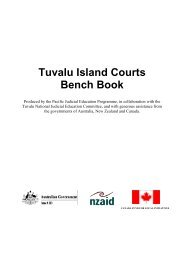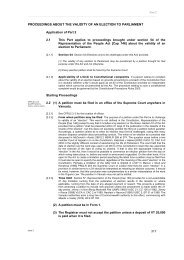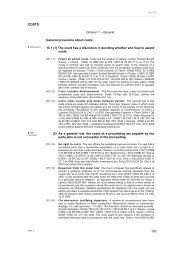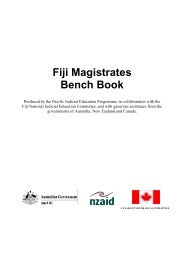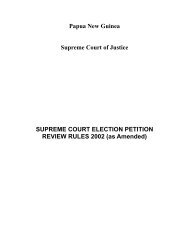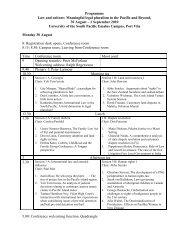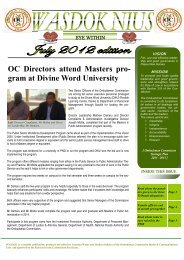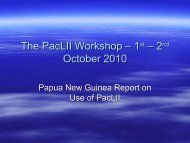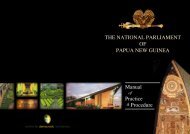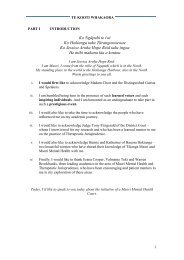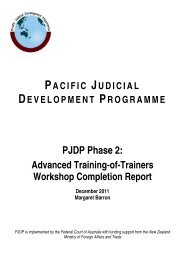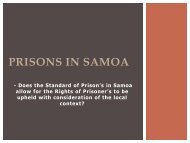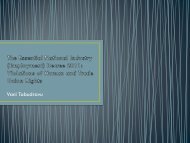Part 7 Interlocutory Matters - PacLII
Part 7 Interlocutory Matters - PacLII
Part 7 Interlocutory Matters - PacLII
Create successful ePaper yourself
Turn your PDF publications into a flip-book with our unique Google optimized e-Paper software.
<strong>Part</strong> 7<br />
_____________________________________________________________________________________________<br />
[7.5.1] Pre-action injunctions The type of order most obviously contemplated by this rule<br />
is the injunction. Note that the prerequisites listed below borrow from the language of<br />
cases such as American Cyanamid v Ethicon [1975] AC 396 at 406-8; [1975] 1 All ER<br />
504 at 509-11; [1975] 2 WLR 316 at 321-4 (which is to be applied in applications for<br />
injunctions in the course of proceedings as in Tropical Rainforest Aromatics v Lui<br />
[2006] VUSC 6 at [6]; CC 1 of 2006; Iririki v Ascension [2007] VUCA 58 at [7]; CC 70<br />
of 2007) but the approach is slightly different in several respects leading to the result<br />
that the test for grant of an injunction (or indeed any interlocutory application) may be<br />
substantively different according to whether the application is made before or during<br />
the proceedings: See for example Dinh v Kontos [2005] VUSC 1; CC 238 of 2004.<br />
(a) the applicant has a serious question to be tried; and<br />
[7.5.2] Meaning of “serious question to be tried” Note that this criterion is differently<br />
expressed to that in subr. (3)(a). The applicant must have a serious question to be tried<br />
in order to qualify to make the application, however, the applicant cannot obtain an<br />
order under the rule unless it is also shown that the applicant is “likely to succeed” upon<br />
the applicant’s evidence.<br />
[7.5.3] Whether necessary to show likelihood of success The “real question to be<br />
tried” described by Lord Diplock in American Cyanamid v Ethicon [1975] AC 396 at<br />
406-8; [1975] 1 All ER 504 at 509-11; [1975] 2 WLR 316 at 321-4 involved a real (as<br />
opposed to fanciful) prospect of ultimate success. It did not require the applicant to<br />
demonstrate a prima facie case in the sense that the applicant was more likely than not<br />
to succeed ultimately. This is, however, what seems to be required by subr. (3)(a), at<br />
least on the applicant’s own evidence.<br />
(b) the applicant would be seriously disadvantaged if the order<br />
is not granted.<br />
[7.5.4] Disadvantage to applicant It is to be noted that the disadvantage in issue is that<br />
of the applicant and there is no reference to the so-called “balance of convenience”<br />
test.<br />
[7.5.5] Meaning of “serious disadvantage” It is suggested that for the disadvantage to<br />
be regarded as “serious” it must be shown that damages would not be an adequate<br />
remedy for the applicant.<br />
(2) The application must:<br />
(a) set out the substance of the applicant’s claim; and<br />
(b) have a brief statement of the evidence on which the<br />
applicant will rely; and<br />
(c) set out the reasons why the applicant would be<br />
disadvantaged if the order is not made; and<br />
(d) have with it a sworn statement in support of the application.<br />
[7.5.6] Consequences of deponent failing to give evidence subsequently If the<br />
deponent does not give evidence at a subsequent trial, comment may be made on the<br />
sworn statement and on any difference between it and subsequent evidence: Earles<br />
Utilities v Jacobs (1934) 51 TLR 43; 52 RPC 72.<br />
(3) The court may make the order if it is satisfied that:<br />
(a) the applicant has a serious question to be tried and, if the<br />
evidence brought by the applicant remains as it is, the<br />
applicant is likely to succeed; and<br />
issue 3 88



